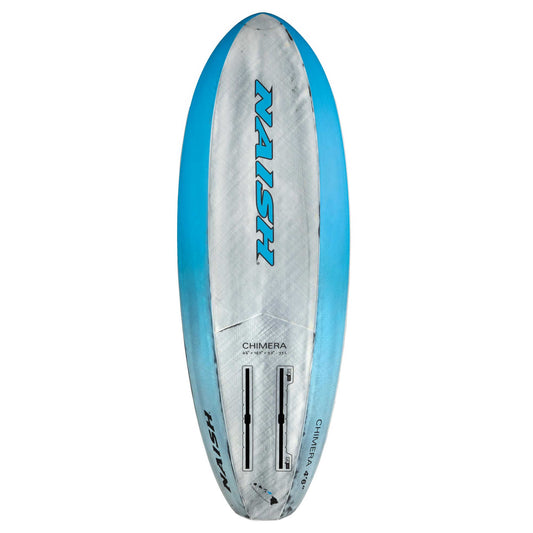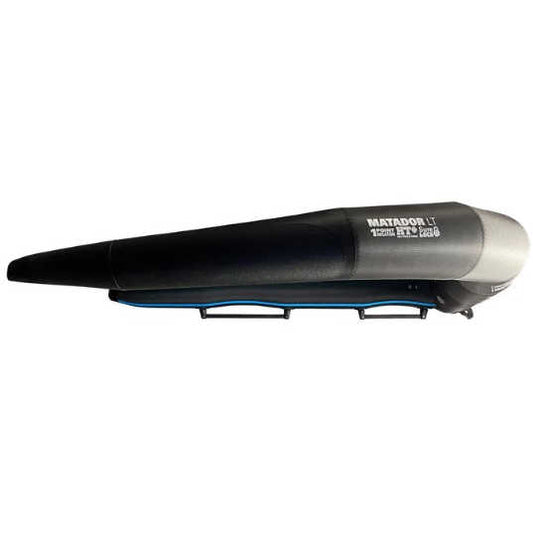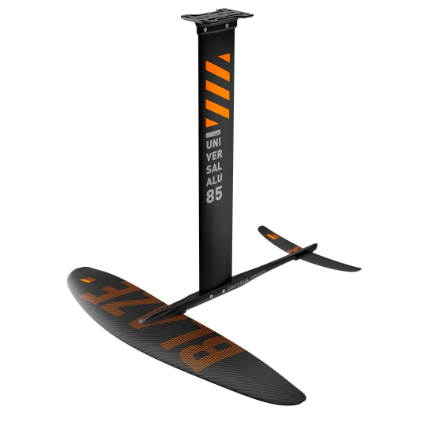Beginner Wing Foiling Guide 2024
India HudsonShare
The newest sport to the watersports world of wing foiling can be confusing with adaptations and upgrades already being shown throughout product ranges; as well as a multitude of different wing and foil sizes and shapes.
If you’re new to the wing foiling sport, we want to highlight the main areas to focus on. There are the three main components you need to build a complete wing foiling package – the wing, the foil and the foil board. These components come in different sizes, but as a beginner we have highlighted a guide of what you need.

- The wing – the hand held wing you hold onto to steer and catch wind
- The foil – the hydrofoil that connects to the ‘fin’ or ‘foil’ box of the board. With speed this accelerates the board up and out of the water for the ‘flying’ sensation
- The foil board – the board you stand on with the wing in your hand
- The front wing – the larger front part of the foil that generates the lift
- The rear wing/ stabilizer – the smaller wing at the back of the foil to help balance and ‘stabilize’ the foil
- The fuselage – the part of the foil that connect the two wings to the mast
- The mast – the part of the foil that connects the fuselage to the board

The Wing
As a beginner we would recommend going for a size between a 4-5m2. This is due to this size being suitable for the best winds to learn wing foiling – 14-25 knots. This size is good for learning also due to the maneuverability for the rider on the water. To decide between a 4m2 or 5m2 would also depend on your size. Generally if you are above 70kg we would say go for the 5m2 to start, and below begin with the 4m2.
Along with other watersports, the size of your rig depends on the wind strength. The stronger the wind, the smaller the wing you will need; and lighter winds will require a much larger size wing.
3m2 – 20-45 knots
4m2 – 14-30 knots
5m2 – 10-25 knots
6m2 – 8-18 knots
7m2 – 5-14 knots

Take a read in more detail at our blog; 'What wing size should I be going for?'
The Foil Board
Whilst learning wing foiling, you want to be on a more stable board to get you going. The general rule we have found is when buying your first wing foiling board, go for a volume that is about 30-40L above your rider weight ( an 80kg rider would go for a 120L foil board). This helps when learning as the greater the volume the more you can actually stand on the board without it sinking before getting up on the foil, to help you get to grips with the wing.
However, we have found more recently that if you have previous experience in watersports that you can aim for aboard litrage that is more 20-30L above your rider weight, as you will likely progress through the initial stages slightly faster and develop onto a smaller board more quickly for foiling. A size around 20-30L above your weight will also be a great size for long-term progression and will be a purchase that will last longer (a bonus to many when investing in kits!).
For example, a previous windsurfer that is 80kg, would suit a 105-110L board, rather than a 120L.
As you progress in wing foiling, you will size down to a much smaller volume board.

The Foil
As mentioned above, a foil is made up from a mast, fuselage and two wings (front and rear wing); all these components can come in different sizes and can determine your style of foiling.
As a beginner wing foiler we would recommend to go for a foil that has a larger surface area front wing, as this is what will provide you the earliest and smoothest lift on the foil to get up and going.
The surface area to go for on a front wing would generally range from 1500-2000.The size foil in this range depends on your size:
If you are a rider around 90kg and new to wing foiling then a 1900-2000 would be suitable.
If you are a rider between 70-90 kg then something 1650-1850 would be a good size.
And if you are 55-70kg, then a 1500 front wing, and generally kids or light riders 50kg and under would go for a 1250 front wing.
The tail wing to pair with this will be slightly larger than other foils but this is to help provide a smoother ride, which is where it gets it’s other name from, the stabilizer.
The mast with the foil is also best to be a slightly longer one, as this will provide a nice height above the water once up. Being higher will also provide a smoother ride as it can keep you from breaching any waves or swell.
The fuselage as a beginner should also be slightly longer to keep increased stability.
The foil set up as above is great for beginning and progressing, it also is a suitable foil to go out in lighter to medium winds that you need as a beginner (15-25 knots) and can pair nicely as a package with a 4/5m wing.

As you progress all components of the foil will get smaller to increase speed and turning abilities or lift for jumps.
FAQ'S (Frequently Asked Questions) -
Can I Wingfoil on a Windsurf Board?
You can learn to wing on a windsurf board, yes. But to foil you will need a windsurf board that is designed to be a crossover model for windsurf foiling and wingfoiling, standard windsurf board will fit a fin and not a foil. It will generally be a shorter windsurf board, but a longer style wing foiling board. An example is the JP X-Foil
Can You Wingfoil on a SUP?
This is a similar response to the previous question. You can't wingfoil on a normal SUP, you can wing on a Windsurfing SUP as it will have a back and centre fin to help you fo upwind when learning. Yet, to wing foil you will need to have a SUP Foil board. Another good example of a SUP board you can wing foil on is the Starboard HyperNut 3in1 (SUP surf, SUP Foil and Wing Foil).
Can You Wingfoil on a Lake?
You can wingfoil anywhere you have wind and momentum to get you going! The lake will just need wind and deep enough water for the foil. ready to go anywhere!
How Fast Can a Wingfoil go?
Fast! Recently recorded you can go (with a lot of practice) up to 27knots on a wingfoil. However, most of us don't reach these speeds and it feels faster on a foil as you have a completely smooth ride. Wingfoiling isn't always about speed, but skill and waves too!
Is Wingfoiling Difficult?
A lot of factors contribute to getting up wingfoiling and we would recommend having a few lessons to get the basics of handling the wing and getting up on the foil. A similar sport to windsurfing, you can get the basics quite easily and quickly, but progression and skills when wingfoiling can be difficult and require a lot of practice. Sports are meant to be a challenge and as such this mirrors why wing foiling is so popular as it is a new challenge for everyone!
Is Wingfoiling Dangerous?
We do recommend some personal protective hardware when wingfoiilng as you can crash into the water at fast speeds and at a height; but also because the foil itself is sharp. However, once wearing a helmet, leash and impact vest for safe measure, there are very little accidents from wing foiling compared to other watersports.
How much does Wingfoiling Cost?
Starting a new sport with new kit is always an investment. To get people into wingfoiling more smoothly, there are many complete wing packages available to purchase as sets with up to 30% off the RRP prices. These can start from £1700 with JP Wing Air Package.
Lessons for wingfoiling can vary depending on if you want lots of lessons to practice if you don't have your own kit yet. Our first wing foiling lessons are 2 hours long and £125 per person.
When was Wingfoiling Invented?
The first Wing Foil Wings came out in 2019 and since then the sport has progressed positively in every direction. There has been great developments in the wings, boards and foils; as well as the tips and tricks for learning.
Is Wingfoiling Harder than Windsurfing?
Yes it is harder than windsurfing, but that is mainly due to the fact that windsurfing requires you to learn how to move along with a sail on a board on the water, compared to a wing on a board above the water on a foil! When foiling, you have to factor in the process of being stable on the board without dropping the foil down to the water again.
Is Wingfoiling Faster than Windsurfing?
When windsurfing, you can reach higher speeds than when wingfoiling. At professional speed courses, windsurfers can reach 56knots; however many skilled riders can reach up to 30 knots. On the foil, wingfoilers can go out in lighter winds and pick up good speeds, but it all depends on the rider and what style of riding they like.
As a beginner, we do suggest getting some supervised practice and tips before venturing out on your own, why not try one of our wing foiling lessons?
We can also provide packages prices on equipment! Just ask or check out Wing Packages!
Nonetheless, take a look at our wing foiling section here to browse our stock!
We hope you have found this helpful, if you have any other questions about beginner wing foiling or progression, please don’t hesitate to call 01202 700503, email info@pooleharbour.co.uk or even pop into our shop at Sandbanks.










